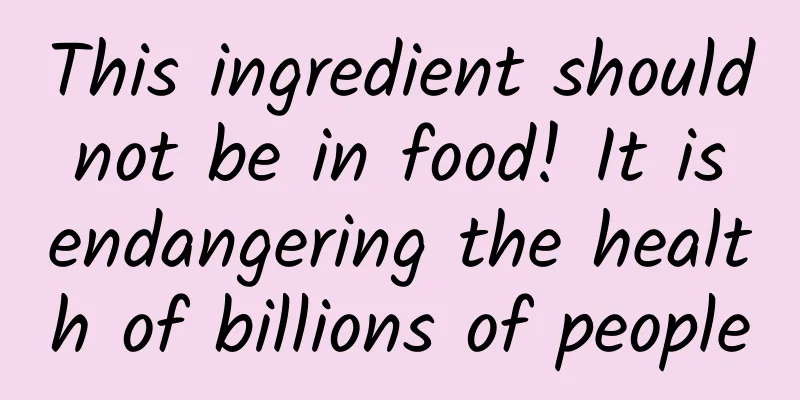This ingredient should not be in food! It is endangering the health of billions of people

|
Fat is a substance that people love and hate. We love its flavor and the nutrition and energy it can bring to the body, but our love for fat often has bad consequences. If we are not careful, we may exceed the limit and cause a series of problems such as obesity, high blood pressure, heart disease, etc. Among the categories of fats, there is a kind of "devil" fat - trans fatty acids, which always enter our bodies silently and destroy our health. Recently, the World Health Organization released a report stating that among the world's 8 billion people, more than 5 billion people consume food containing industrially produced harmful trans fats, which increases their risk of heart disease and death. So, what exactly is the "trans fat" that is "criticized" by the World Health Organization? What are trans fats? Trans fats, also known as trans fatty acids, are unsaturated fatty acids that may appear in natural or processed foods. In the processed food sector, trans fats are produced when solid fats such as margarine are produced by hydrolyzing oils. They can also be produced by heat-treating vegetable oils. Foods that contain high amounts of trans fats include baked goods, sweets, fried potato products and ready meals. Where do trans fats come from? When vegetable oil is hydrogenated, trans fatty acids are produced, which we call hydrogenated vegetable oil. Trans fatty acids appear on the market under various names, such as cocoa butter substitute, shortening, margarine, artificial butter, non-dairy creamer, etc., all of which are made from hydrogenated vegetable oil. Generally, we see food labels with zero trans fatty acids, but this does not mean that it is 100% trans-free. The General Rules for Pre-packaged Food Labeling stipulate that if the trans fatty acid content in every 100 grams of food is less than 0.3 grams, it can be marked as zero. So it still depends on whether there are ingredients such as margarine, non-dairy creamer, and vegetable creamer in the ingredient list. The country stipulates that the intake of trans fatty acids should not exceed 1% of daily calories, which is actually two grams. When we cook food in our daily lives, trans fatty acids will be produced when the oil is heated to a certain degree. It is recommended that you keep the temperature as low as possible when cooking, use hot pans and cold oil, and try to avoid hot pans and hot oil. Where do trans fats come from? 1. Five foods contain natural trans fatty acids Natural trans fatty acids are rare in nature, and their food contribution rate is only 28.83%. The medical community has not yet clarified their relationship with human obesity, cardiovascular disease, etc. Therefore, you only need to pay a little attention and there is no need to be overly cautious. Excessive resistance to natural trans fatty acids may lead to insufficient nutritional sources and increase the risk of malnutrition. Five foods that contain natural trans fatty acids are: beef, lamb, milk, goat milk, breast milk, etc. 2. Trans fats are widely found in desserts and fried foods The most common desserts and fried foods in daily life all contain trans fatty acids. After all, the contribution rate of trans fatty acids from processed foods is as high as 71.17%. They can be roughly divided into: candies, pastries, biscuits, puffed foods, snacks, beverages, condiments (salad dressings, solid soups), breakfast (fried dough sticks), etc. 3. Pay attention to "hidden" trans fatty acids Now many people are aware of the harm of trans fatty acids and pay special attention when checking the ingredient list. In order to deal with this situation, merchants have come up with a substitute strategy, that is, changing the name. In fact, margarine, vegetable shortening and all vegetable oils containing the word "hydrogenated" (hydrogenated soybean oil, hydrogenated palm oil, hydrogenated vegetable oil, etc.) in the ingredient list are just "substitutes" for trans fatty acids. What is the optimal amount of trans fat intake? It is impossible to completely avoid trans fatty acids. People can only try to control the total amount of intake within a safe range to get closer to the goal of protecting health. So what is the upper limit of trans fatty acid intake per day? The World Health Organization has found that the body's intake of trans fatty acids is only one percent of total energy. The Chinese Dietary Guidelines recommend that adults consume no more than 2 grams of trans fat per day. Everyone can follow these two standards and plan their dietary structure reasonably. The overall goal is to eat as little trans fat as possible while ensuring adequate nutrition. The existence of trans fatty acids was originally a pursuit of food, but it has created a health obstacle. However, it is now almost everywhere and has become a dietary habit for many people, so it is not easy to say "no" to trans fatty acids. Remind everyone: the pursuit of food is certainly a pleasure in life, but we must also face up to the harm of trans fatty acids, pay attention to improving our eating habits in life, learn to plan nutritional supplements, and be a happy "eater". |
Recommend
WeChat enters the deep waters of monetization: the focus this year may be advertising
As a tool for communication and social interactio...
Why do birds make different calls?
It is the season of birds singing, flowers bloomi...
Why do I recommend that you really dry your quilt regularly?
Among all animal phobias, spider phobia is defini...
There is new news about China’s moon landing program!
When will the Chinese achieve their goal of landi...
Indie Developers’ Anthem: Craftsmanship
The following is from Xhacker's Base: I am a ...
OPPO R5, the world's thinnest 5-inch OPPO R5, is 4.85mm thick and is the best choice for iPad Air 2
Thinness has always been a dimension that smartph...
Douyu Live Product Analysis Report!
Game players should be familiar with Douyu Live, ...
Does washing your hair every day cause hair loss? Here are 5 truths about washing your hair →
Do you have it too? Such experience ↓↓↓ Scalp itc...
Channel promotion for APP user growth!
A successful app always relies on user growth. If...
Private domain traffic SOP guide!
The topic I want to talk about today: private dom...
The International Space Station is about to be decommissioned. Where will it go? Will it fall or be recovered?
Although the service life of the International Sp...
IBM's latest quantum computing progress: Is quantum computing's chatGPT moment coming soon?
In June 2023, IBM Quantum and its partners, inclu...
To make your circle of friends explode, you need to know these 10 article illustration styles!
A newbie's talk: In addition to the content, ...
What is Meituan’s agency operation? Which businesses are suitable?
Nowadays, most white-collar workers rely on order...









